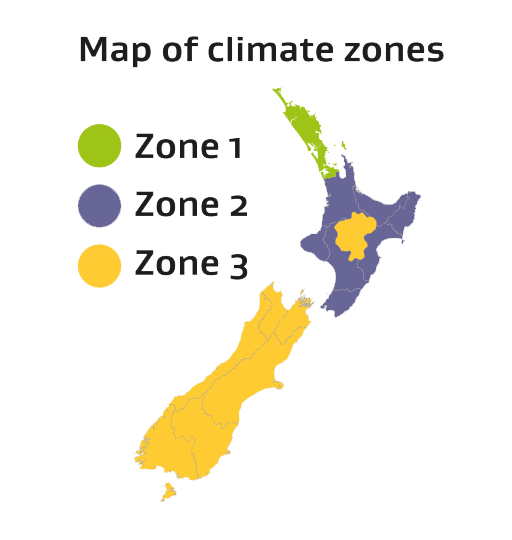Ceiling and underfloor insulation is compulsory in all rental homes. Find out more about insulation standards for rental properties.
Landlords who do not meet their obligations under the healthy homes standards are in breach of the Residential Tenancies Act 1986 – and may face consequences, like financial penalties of up to $7200.
Landlords who are not sure where to start, read our healthy homes toolkit for landlords.
What is the insulation standard?
Insulation stops heat escaping from the house. In general, the better insulated a home is, the more it will retain heat. This means:
- it will usually cost less to heat the property
- the property will be drier
- the property will be less prone to mould.
All private rentals must comply with the healthy homes insulation standards.
More detail about the insulation standard is available in the guidance document.
Use the online tool to find out if you need to upgrade the insulation in your rental property to meet the healthy homes standards.
The required level for insulation
Insulation requirements are measured by R-value. R-value is a measure of resistance to heat flow. The higher the R-value, the better the insulation.
Minimum R-values vary across New Zealand.
Climate zones for properties which received building consent before 3 November 2022. Use this map to check what zone your property is in.
|
|
Zone 1 — ceiling R 2.9, underfloor R 1.3 Zone 2 — ceiling R 2.9, underfloor R 1.3 Zone 3 — ceiling R 3.3, underfloor R 1.3 |
The R-value of new insulation is on the product packaging. For existing insulation, check the ceiling or underfloor space as the R-value from the packaging may be stapled to a beam. You can also measure the thickness yourself or consult a professional insulation installer. Existing ceiling insulation that was installed before 1 July 2016 must be at least 120mm thick.
Ceiling insulation that is less than 120mm thick is acceptable if the landlord can prove:
- the insulation’s R-value met the minimum R-values (2.9 or 3.3 depending on the climate zone) when it was installed, and
- the insulation’s thickness has not degraded by more than 30% (compared to when it was installed).
Insulation must be installed in accordance with New Zealand Standard4246:2016.
Installing bulk thermal insulation in residential buildings PDF [PDF, 6 MB]
All existing insulation must still be in reasonable condition to meet the requirements. This means there should be no mould, dampness, damage or gaps.
New builds and consented renovations
All new builds and renovated properties requiring consent will need to meet the minimum insulation requirements in the 2021 Building Code update.
2021 Building Code update — Building Performance(external link)
If the property meets the 2021 Building Code insulation requirements, it also meets the healthy homes insulation standard. The 2021 Building Code insulation requirements exceed the healthy home standards insulation requirement.
Insulation top up for an existing property
Landlords that install or top up ceiling and underfloor insulation in their existing rental properties will need to comply with the healthy homes insulation standard, but do not need to meet the 2021 Building Code insulation requirements (provided the property is not undergoing renovations that require building consent).
Exemptions to the insulation standard
There are 3 specific insulation exemptions.
More information on these exemptions is available in Subpart 3 of the Healthy Homes Standards Regulations.
Subpart 3—Insulation standards — Legislation New Zealand(external link)
If access is impracticable or unsafe
Some areas of some homes may be unsafe or not reasonably practicable to access. This may be due to:
- their design
- limited access
- potential for substantial damage
- health and safety reasons.
There is an exemption for parts of homes where a professional installer is unable to access and/or insulate, until this becomes possible, for example, when a property is re‑roofed (this does not include having to create an access way).
Partial exemption for certain underfloor insulation
If the rental home has existing underfloor insulation that was installed when the home was built or converted. This insulation must still be in reasonable condition. Landlords must have a copy of any compliance documents that shows the home met the requirements of the time. For example:
- code compliance certificate
- certificate of acceptance
- another relevant compliance document.
Ceilings and floors with other habitable spaces directly above or below
The third exemption applies to areas of ceilings or floors where there are other habitable spaces directly above or below. This might be another floor of the same property or another apartment. These areas do not require insulation to meet the healthy homes insulation standard.
General exemptions to the healthy homes standards
Examples of insulation exemptions
- "Foil insulation is installed in the subfloor and I have the appropriate compliance documents."
- "It is not reasonably practicable for a professional to install underfloor insulation in some areas due to the slope of the land, as there is not enough space under the kitchen (including part of the hallway outside the kitchen) and bedroom 3 for a professional to access the area to install insulation."
- "The property is built on a concrete slab; therefore there is no suspended floor area in which to install insulation."
- "Insulation information is not available in the council building file. The underfloor space is also too narrow for a professional assessor to gain access and provide an assessment. The landlord confirms that all reasonable steps have been taken to find this information." Note: cutting an access hatch doesn't count as major building work.
- "Installation is not reasonably practicable because the property has a skillion roof throughout and there is not enough space for a professional installer to access the areas to install insulation."
- "Insulation information is not provided in the council building file. The ceiling space is also inaccessible and substantial building work would be required to gain access. Specifically, in order to access the ceiling space, the roof would need to be lifted. The landlord confirms that all reasonable steps have been taken to find this information."
Last updated: 01 July 2025


